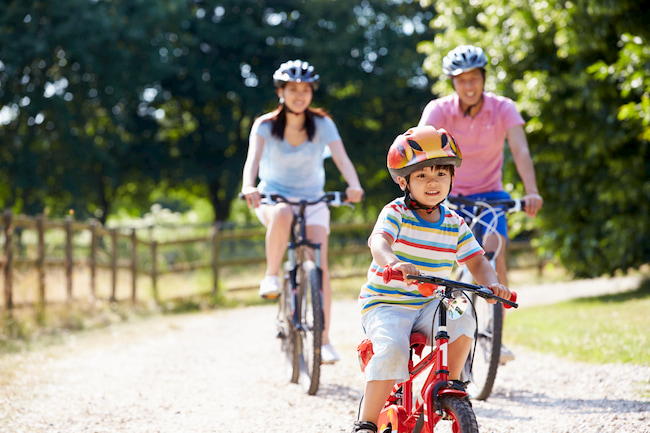You insist your child buckle up when he or she is riding in your car, so why wouldn’t you insist on a similar safety measure on a bicycle, skateboard, hoverboard or scooter? A helmet is an essential!
Why is a helmet so important? Well, it’s pretty simple. When it comes to bicycles, injuries are fairly common — in 2015 alone, there were more than 450,000 bicycle-related injuries. And they’re most common among young people.
According to the Centers for Disease Control and Prevention, children ages 5 to 14 and adolescents between ages 15 and 19 have the highest rates of bicycle injuries. While injuries like sprains, strains and fractures are fairly common, head injuries are the most common in accidents related to in-line skates, bicycles, skateboards and scooters.
That’s where a helmet comes into play. Wearing a helmet has been shown to reduce the risk of head injury by as much as 85 percent. So, how can you find a helmet that’s right for your child? Read on as we offer some suggestions.
Finding the right bike helmet
When it comes to a helmet, it’s not enough just to pick up any old helmet. You need to find one that fits your child appropriately and meets recognized standards. If your child performs tricks on a skateboard often, you may want to look for a helmet specifically designed for that purpose.
- Look for the safety sticker. A proper helmet should have a Consumer Product Safety Committee sticker inside of it. This quality measure ensures that the helmet will provide the highest level of protection in case of impact with an object or the ground. All helmets manufactured after 1999 should meet this standard.
- Steer clear of hand-me-downs in some cases. It might seem like you can just pass down an older child’s bike helmet to a younger child, but there are some instances where you need to avoid this. Any helmet that is known to have been worn in an accident — or one that contains visible cracks — should not be used again. Older helmets that haven’t been used in a while may contain cracks you can’t see, so you may want to buy a newer model in that instance.
- Make sure the helmet fits. You want a helmet that has a snug but comfortable fit when the chin strap is buckled. The straps on the helmet should be even and form a Y at the bottom of the ear lobe. A helmet should sit evenly on the top of the head in a level position. The helmet should not rock forward, backward or side to side when buckled. The child should be able to see the bottom rim of the helmet when looking up. The child should be able to open his or her mouth as wide as they can and feel the helmet hug the head. If not, the straps are too loose and need to be tightened. You’ll want to purchase new helmets as your child outgrows the old ones.
- Ensure safety once the helmet is on. Have your child put on his or her bike helmet. Once the helmet is securely fastened, check to ensure that your child can still hear and see you clearly. The rim should be one to two fingers widths above the eyebrows. It could be very dangerous if your child is unable to hear surrounding noise on a ride due to the helmet impeding hearing.
Other helmet basics
Beyond purchasing the right helmet, the other hard part is ensuring your child wears a helmet every time while riding, skating, or scooting.
Your first step to making it a more appealing proposition is to allow your child to help pick out the helmet. Once you’ve made sure that it fits properly, the aesthetics can be whatever your child likes best.
You’ll also want to be a good role model. If you’re riding a bike, you also should be wearing a helmet. This can help your child see that it’s the cool thing to do and model the behavior.
Lindsay Bass, BSN, RN, is the Pediatric Trauma Injury Prevention & Outreach Coordinator at Children’s Hospital at Erlanger. She is a Child Passenger Safety Technician and leads the Southeast Coalition for Safe Kids and Children’s Hospital at Erlanger Safe & Sound program. If you have questions about bike helmet safety, please call (423) 778-6691.
A head injury is always an emergency. If your child experiences a head injury while riding a bike or during some other activity, seek medical attention. Children’s Hospital at Erlanger offers specialized emergency care designed with the unique needs of children in mind.







